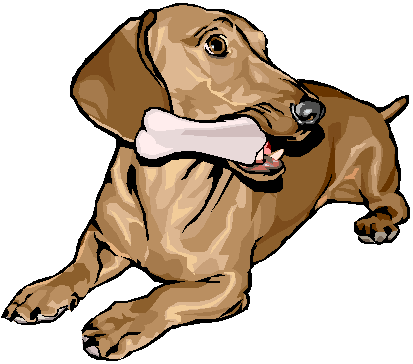Step 1 – Start With A Relaxed Dog And No
Toothbrush
Start by giving your dog a body massage with
occasional small food treats. If the dog is
hyper-excited about the treats, either use a less
exciting treat or phase treats out by emphasizing
petting and praise. Focus your gentle massage on the
face and begin to massage the cheeks using the same
circular motion you will later use to brush the
teeth.
Step
2 – Introduce The Toothpaste On Your Finger
Hold your dog the same as when you are cuddling
her. Once the dog is comfortable with your finger
massage of her cheeks, place a dab of toothpaste on
your finger and let her taste it. If she likes it,
give another dab, but try to place it in a different
area of the mouth such as between the teeth and
cheek.
Step
3 – Introduce the Finger Brush
Before introducing the brush, an intermediate step
is to use a finger brush (CET Finger Brush™) that
fits over a finger, but has some small bristles. Put
a dab of the paste on this tool, and begin to rub
the paste on just one or two teeth. Try to
stop the session before the dog starts
struggling. If it becomes a wrestling match,
brushing will not easy or fun. The goal is to go
slowly and keep it enjoyable for the dog.
Step
4 - Introduce the Toothbrush
Place a small amount of toothpaste on the dog
toothbrush. Let the dog lick the material off
the brush. The second or third dab, put the brush
against a tooth and smear the paste. In a gentle
circular motion, brush only one or two teeth then
give it a break. Be gentle, use a happy tone, lots
of praise, and intermittent treats. The purpose of
this step is to get your dog accustomed to the feel
of the brush. If the brush is repeatedly rejected,
try beginning with a cotton tipped applicator, then
reintroduce the brush later.
|
The goal is to go slowly and
keep it enjoyable for the
dog.
Be
gentle, use a happy tone,
lots of praise, and
intermittent treats. |
Step 5 - Begin Brushing
It
might take several sessions to gradually increase
the number of teeth brushed. The goal is to
eventually brush the rear teeth where plaque and
tartar have a greater tendency to accumulate.
Go slowly and gently. Stop brushing before
your dog begins to fuss, or she might learn fussing
works. Build up to about 30 seconds per
side. Dogs build up much tartar on the inside
surfaces of their teeth, so focus on the outside
surfaces. Once things are going well, focus
attention on the big teeth in back. 
Step
6 – Between Brushing
Dental tartar and plaque start building up six to
eight hours after the last brushing, so the goal is
to brush daily, and have some auxiliary strategies.
Some veterinarians suggest bones, but these are
controversial. It is possible to break teeth, or get
intestinal obstruction. However, this is the
exception, and many dogs chew bones for life without
a problem. The key is to introduce chews early
with careful supervision and to follow these
guidelines.
1.
Feed dry food not canned
food or dry food with moisture added.
2. Give treats
that also clean the teeth: e.g. Dentabone™
(Waltham); CET Chews™ (Vibrac)
3. Play pull games
with dental cleaning rope toys but don't allow
canine teeth on human skin or clothes
Teach positive chewing
If possible, introduce
rawhide chews (and other desirable chew toys) when
the dog is still a puppy. Give rawhides for short
periods of time (e.g., 10 minutes), then "trade up."
This means request a "sit," and offer a
tastier treat so that the dog surrenders the chew
voluntarily. Don't allow novice dogs to chew
rawhides unsupervised as they may in fact swallow
too much at once and get sick. Remove and replace
the chew when it is small enough to be swallowed.